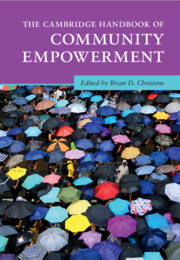Book contents
- The Cambridge Handbook of Community Empowerment
- Cambridge Handbooks in Psychology
- The Cambridge Handbook of Community Empowerment
- Copyright page
- Contents
- Figures
- Tables
- Contributors
- Building Community Power
- Part I Organizing and Activism
- 1 Youth Organizing
- 2 Youth Activism in Postapartheid South Africa
- 3 Domestic Violence and Community Organizing in India
- 4 Congregation-Based Community Organizing
- 5 Immigrant Organizing and Activism
- 6 Online Racial Justice Advocacy
- Part II Participatory Governance
- Part III Civil Society and Coalitions
- Part IV Enterprise
- Part V Participatory and Community Arts
- Part VI Education and Engaged Research
- Contributor Details
- Index
- References
5 - Immigrant Organizing and Activism
from Part I - Organizing and Activism
Published online by Cambridge University Press: 18 April 2024
- The Cambridge Handbook of Community Empowerment
- Cambridge Handbooks in Psychology
- The Cambridge Handbook of Community Empowerment
- Copyright page
- Contents
- Figures
- Tables
- Contributors
- Building Community Power
- Part I Organizing and Activism
- 1 Youth Organizing
- 2 Youth Activism in Postapartheid South Africa
- 3 Domestic Violence and Community Organizing in India
- 4 Congregation-Based Community Organizing
- 5 Immigrant Organizing and Activism
- 6 Online Racial Justice Advocacy
- Part II Participatory Governance
- Part III Civil Society and Coalitions
- Part IV Enterprise
- Part V Participatory and Community Arts
- Part VI Education and Engaged Research
- Contributor Details
- Index
- References
Summary
This chapter examines the power and empowerment processes taking place in immigrant organizing and activism, primarily in the US. Immigrant youth activism around the Federal DREAM Act provides a case example. The youth whose activism and organizing seek the passage of this act are often referred to as “the DREAMers.” The discussion of the DREAMers is followed by a synthesis of interdisciplinary literature on immigrant community power and psychological empowerment processes. The chapter concludes with recommendations for policymakers, politicians, and social science researchers. Policymakers need a better understanding of the effects of their decisions on the large, heterogeneous group of noncitizen immigrants whose lives are interconnected with those of US citizens (e.g., undocumented parents of citizen children). Social scientists should pay attention to the similarities and differences between immigrant and refugee organizing and activism and should engage in collaborations with immigrant community leaders on mutually beneficial research.
- Type
- Chapter
- Information
- The Cambridge Handbook of Community Empowerment , pp. 139 - 161Publisher: Cambridge University PressPrint publication year: 2024

